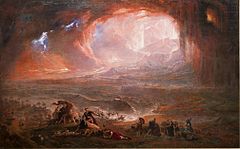Eruption of Vesuvius
| Eruption of Mount Vesuvius in 79 | |
|---|---|

Destruction of Pompeii and
Herculaneum by John Martin |
|
| Volcano | Mount Vesuvius |
| Date | August 24–25, 79 AD (probable) |
| Type | Plinian |
| Location |
Campanian volcanic arc, Italy 40°49′N 14°26′E / 40.817°N 14.433°ECoordinates: 40°49′N 14°26′E / 40.817°N 14.433°E |
| VEI | 5 |
| Impact | Buried the Roman settlements of Pompeii, Herculaneum, Oplontis, and Stabiae. |
The eruption of Mount Vesuvius in 79 AD was one of the most catastrophic volcanic eruptions in European history. Historians have learned about the eruption from the eyewitness account of Pliny the Younger, a Roman administrator and poet. It is the namesake for Plinian eruptions.
Mount Vesuvius spewed a deadly cloud of volcanic gas, stones, and ash to a height of 33 kilometres (21 mi), ejecting molten rock and pulverized pumice at the rate of 1.5 million tons per second, ultimately releasing a hundred thousand times the thermal energy of the Hiroshima bombing. Several Roman settlements were obliterated and buried underneath massive pyroclastic surges and ashfall deposits, the most well known being Pompeii and Herculaneum.
The remains of about 1,500 people have been found at Pompeii and Herculaneum, but the overall death toll is still unknown.
The 79 AD eruption was preceded by a powerful earthquake seventeen years before on February 5, 62 AD, which caused widespread destruction around the Bay of Naples, and particularly to Pompeii. Some of the damage had still not been repaired when the volcano erupted. The deaths of 600 sheep from "tainted air" in the vicinity of Pompeii, reported by Seneca the Younger, leads vulcanologist Haraldur Sigurdsson to compare them to similar deaths of sheep in Iceland from pools of volcanic carbon dioxide and to speculate that the earthquake of 62 AD was related to new activity by Mount Vesuvius.
...
Wikipedia
